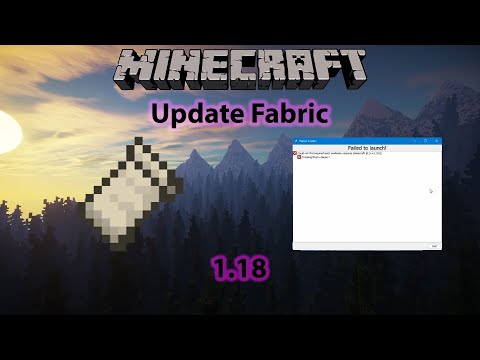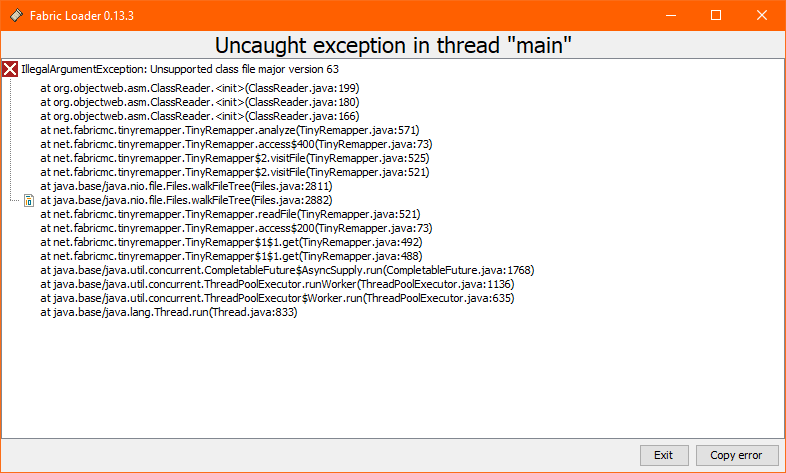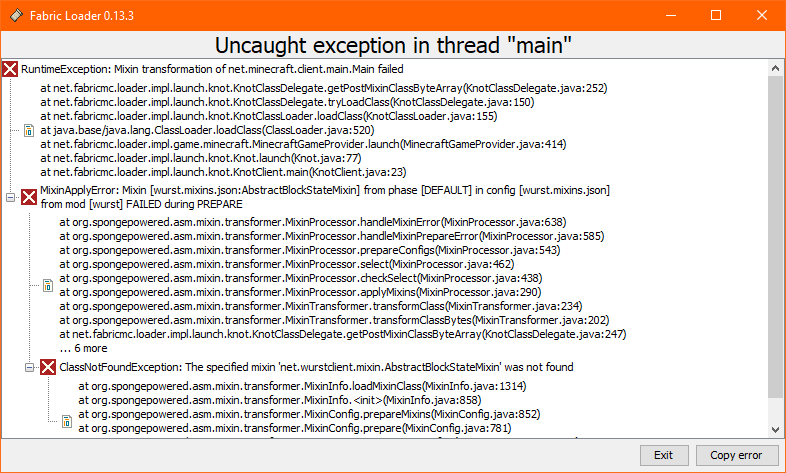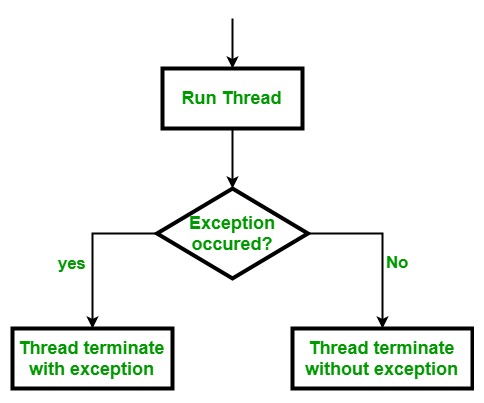Uncaught Exception In Thread Main Fabric
Introduction:
An uncaught exception in the main thread is a critical issue that can disrupt the execution of a program or even cause it to crash. This article will explore the concept of uncaught exceptions in the main thread, including its causes, impacts, techniques for handling them, best practices for prevention, and tools/frameworks available for detection. We will also discuss the frequently asked questions regarding these exceptions.
1. What is an uncaught exception in the main thread?
In Java programming, the main thread is the primary thread responsible for executing the main method. An uncaught exception occurs when an exception is thrown but not caught or handled by the program. This means that the program does not have any exception handling code (try-catch block) to handle the exception, leading to the termination of the program.
2. Causes of uncaught exceptions in the main thread:
Multiple factors can contribute to uncaught exceptions in the main thread. Some common causes include:
a) Programming errors: This occurs when the code contains logical or syntax errors that lead to exceptions. These errors could be related to null pointers, array out of bounds, or division by zero, among others.
b) External dependencies: When a program relies on external libraries or frameworks, the absence or incorrect usage of these dependencies can result in uncaught exceptions.
c) Insufficient error handling: If a program lacks proper error handling mechanisms, such as try-catch blocks or exception propagation, uncaught exceptions are more likely to occur.
3. Impact of uncaught exceptions in the main thread:
Uncaught exceptions in the main thread can have significant consequences:
a) Termination of program: When an uncaught exception occurs, the program terminates abruptly, leaving any pending operations or resources in an inconsistent state.
b) Data loss: If the exceptions occur during critical operations or while manipulating data, the loss of data can be a severe consequence.
c) Poor user experience: If the program is an application or a web page, uncaught exceptions can result in crashes or unexpected behaviors, leading to frustration for end-users.
d) Debugging challenges: Uncaught exceptions can complicate the debugging process, making it harder for developers to identify the exact cause and location of the error.
4. Techniques for handling uncaught exceptions in the main thread:
To handle uncaught exceptions effectively, the following techniques can be employed:
a) Try-catch blocks: Surrounding the susceptible code blocks with try-catch blocks allows the program to catch and handle exceptions gracefully.
b) Exception propagation: Instead of handling the exception directly, allow it to be passed up the call stack until a suitable handler is found.
c) Logging: Implement robust logging mechanisms that capture and log the exception details, aiding in the identification and resolution of the issue.
d) Graceful termination: When a critical uncaught exception occurs, it is essential to gracefully terminate the program, ensuring any necessary cleanup or resource releasing is performed.
5. Best practices for preventing uncaught exceptions in the main thread:
To minimize the occurrence of uncaught exceptions in the main thread, the following best practices should be followed:
a) Defensive programming: Writing code with robust error checking and validation can help prevent many exceptions from occurring in the first place.
b) Proper error handling: Implementing appropriate error handling mechanisms, such as try-catch blocks or exception propagation, ensures that exceptions are caught and dealt with appropriately.
c) Documentation: Provide clear documentation detailing the intended usage, limitations, and exception handling requirements for external dependencies or libraries.
d) Code reviews: Conduct thorough code reviews to identify potential sources of uncaught exceptions and ensure adherence to best practices.
6. Tools and frameworks for detecting uncaught exceptions in the main thread:
Various tools and frameworks can assist in detecting uncaught exceptions in the main thread, including:
a) IDEs (Integrated Development Environments): IDEs like Eclipse, IntelliJ IDEA, and NetBeans provide features to highlight and flag uncaught exceptions in the codebase.
b) Logging frameworks: Utilizing logging frameworks like Log4j or SLF4J can help capture exceptions and stack traces, enabling developers to identify uncaught exceptions during runtime.
c) Exception monitoring tools: Tools like Sentry, Bugsnag, or Raygun offer real-time exception tracking and monitoring, providing insights into uncaught exceptions, their impact, and possible resolutions.
d) Unit testing frameworks: By creating comprehensive unit tests that cover various scenarios, unit testing frameworks such as JUnit or TestNG can help catch potential uncaught exceptions during development.
FAQs – Frequently Asked Questions:
Q1: What is the difference between ‘uncaught exception in thread main’ and ‘exception in thread main’?
A1: The term ‘uncaught exception in thread main’ refers to an exception that is thrown but not caught or handled by the program, leading to program termination. On the other hand, ‘exception in thread main’ refers to an exception that is thrown and caught (or handled) by the program, preventing unexpected termination.
Q2: What does “java.lang.NoClassDefFoundError” mean in the context of an uncaught exception in the main thread?
A2: The “java.lang.NoClassDefFoundError” error occurs when the Java Virtual Machine (JVM) cannot locate a required class at runtime. This can happen if the class is missing from the classpath or if there is an issue in the class’s definition.
Q3: How can I debug an uncaught exception in the main thread effectively?
A3: To debug an uncaught exception, examine the stack trace provided by the exception message. It often includes the class, method, and line number where the exception occurred, assisting in locating the issue. Additionally, logging frameworks and IDE features can help capture more detailed information about the exception.
Conclusion:
Understanding uncaught exceptions in the main thread is crucial for developing reliable and stable applications. By identifying the causes, impacts, prevention techniques, and available tools, developers can minimize the occurrence of these exceptions and provide a seamless user experience. Remember to follow best practices, handle exceptions appropriately, and utilize relevant tools and frameworks to detect and address uncaught exceptions effectively.
Updating The Minecraft Fabric Loader For 1.18/1.19 2021 (Fix Fabric Failed To Launch!)
Keywords searched by users: uncaught exception in thread main fabric Uncaught exception in thread main, Exception in thread main, Uncaught exception in thread main fabric, Exception in thread main” java lang NoClassDefFoundError
Categories: Top 10 Uncaught Exception In Thread Main Fabric
See more here: nhanvietluanvan.com
Uncaught Exception In Thread Main
When you are working with programming languages, encountering errors is a part of the process. One common error that programmers come across is the “Uncaught exception in thread main” error. This error can be frustrating, especially for beginners who are not familiar with troubleshooting such issues. In this article, we will explore the nature of this error, its causes, and potential solutions to help you overcome it.
Understanding the “Uncaught exception in thread main” Error:
In simple terms, an uncaught exception refers to an exception that occurs during the execution of a program and is not properly handled or caught by the program itself. The term “thread main” refers to the main thread of execution in a program. When an uncaught exception occurs in this thread, it means that the program was unable to handle the exception appropriately, leading to the error message.
Causes of the “Uncaught exception in thread main” Error:
1. Missing exception handling: One of the most common causes of this error is the absence of proper exception handling in your code. Exception handling is essential to catch and handle any runtime errors gracefully.
2. Runtime exceptions: Runtime exceptions, such as division by zero, array out of bounds, or null pointer exceptions, can also trigger the “Uncaught exception in thread main” error. These exceptions occur during program execution and need special handling mechanisms.
3. Dependencies and libraries: In some cases, the error may be caused by missing or incompatible dependencies or external libraries. If your program relies on external resources that are not properly set up, it may result in an uncaught exception.
Troubleshooting the “Uncaught exception in thread main” Error:
Now that we understand the possible causes, let’s explore some troubleshooting steps to help resolve the issue:
1. Identify the exception: Look for the specific error message associated with the exception. It often provides valuable information about the cause of the problem and helps pinpoint the exact line of code where the error occurred. Understanding the exception type is crucial for finding an appropriate solution.
2. Check your code: Examine your code thoroughly to ensure that you have implemented proper exception handling mechanisms. Make sure that try-catch blocks are in place to catch any potential exceptions. If not, add appropriate try-catch blocks to handle potential exceptions.
3. Analyze the error message: Decode the error message to gather more information about the root cause of the problem. Pay attention to any error codes, stack traces, or file paths mentioned in the error message. These details can guide you towards a potential solution.
4. Test with sample inputs: Test your code with different inputs and scenarios to identify any patterns or specific inputs that may trigger the error. This can help you narrow down the issue and find a targeted fix.
5. Debugging your code: Utilize debugging tools provided by your programming environment to step through your code and identify where the error occurs. Debugging allows you to inspect variables, track the flow of your program, and pinpoint the problematic segment.
Frequently Asked Questions (FAQs):
Q1. Can I ignore the “Uncaught exception in thread main” error and continue running the program?
A1. Ignoring the error is generally not recommended, as it indicates a flaw in your code or a runtime issue that needs attention. Uncaught exceptions can lead to unexpected behavior, program crashes, or incorrect output.
Q2. How can I fix the “Uncaught exception in thread main” error caused by incompatible dependencies?
A2. Ensure that your program’s dependencies are up to date and compatible with your codebase. Check the documentation or official resources for those dependencies for any known issues or necessary configuration steps.
Q3. What if I am unable to identify the cause of the error after following the troubleshooting steps?
A3. If you are still unable to resolve the error, seeking assistance from online forums, developer communities, or even reaching out to experienced programmers for help can be beneficial. Sharing detailed information about the error and your code can aid in identifying the root cause.
Q4. Are there any best practices to prevent “Uncaught exception in thread main” errors?
A4. Yes, some best practices include implementing robust exception handling mechanisms, validating inputs, and properly managing external dependencies. Writing clean and modular code can also minimize the chances of encountering these errors.
In conclusion, encountering the “Uncaught exception in thread main” error can be a frustrating experience for any programmer. However, by understanding the causes and following the troubleshooting steps provided in this article, you can effectively resolve this issue and continue progressing with your programming projects. Remember, thorough analysis, debugging, and proper exception handling can help you overcome most uncaught exceptions and build more reliable software solutions.
Exception In Thread Main
The main method is the entry point of a Java program, serving as the starting point for program execution. When an exception is thrown within this method, whether it is a runtime exception or a checked exception, the program terminates abruptly, and the execution is halted. The error message “Exception in thread main” simply informs the programmer that an exception has occurred within the main thread of execution.
There are several potential causes for this error message. Here are a few common scenarios that could trigger an exception:
1. Unhandled Exception: If an exception occurs within the main method, and it is not handled explicitly through an exception handling mechanism such as try-catch blocks or throws clause, it will propagate up the call stack, reaching the JVM’s default handler. As a result, the program terminates, and the error message is displayed.
2. Incorrect Method Signature: Another possible cause is when the main method’s signature is incorrectly defined. In Java, the main method must have a specific signature: public static void main(String[] args). If the signature is incorrect or misspelled, the JVM is unable to find the entry point of the program, resulting in the “Exception in thread main” error.
3. Missing or Incorrect Classpath: If the program depends on any external libraries, and the classpath is not set correctly, the JVM may fail to load the required classes. Consequently, the program crashes with the aforementioned error message.
4. Syntax or Logical Errors: Programming mistakes such as typos, incorrect syntax, or logical errors can also trigger exceptions. These errors may interfere with the normal flow of the program and result in an unhandled exception within the main method.
To troubleshoot and resolve the “Exception in thread main” error, the following steps can be taken:
1. Review the Error Message: Carefully read the entire error message, as it often provides valuable insights into the cause of the exception. The error message may contain relevant information, such as the class or method where the exception occurred, stack trace, and the specific exception type.
2. Check Syntax and Logic: Inspect the code for any syntax or logical errors. Make sure the code conforms to the Java language rules and is logically correct. Debugging tools, such as breakpoints or print statements, can help identify the location of the exception.
3. Implement Exception Handling: If the exception is known or expected, enclosing the code block inside a try-catch statement can prevent the abrupt termination of the program. The catch block can handle the exception gracefully by providing alternative logic or error messages.
4. Verify Classpath: Confirm that the classpath is correctly set, especially when using external libraries or dependencies. Check that the required JAR files are accessible by the program.
5. Check Main Method Signature: Ensure the main method’s signature is correct and matches the specified format: public static void main(String[] args).
Now, let’s move on to some frequently asked questions related to the “Exception in thread main” error:
Q1. What should I do if the error message shows a specific exception type?
A1. First, identify the type of exception displayed. It helps to understand the specific problem causing the exception. Look up the exception in Java documentation or search for it online to learn about common causes and appropriate solutions.
Q2. How can I identify the exact location where the exception occurred?
A2. The error message generally includes a stack trace that displays the sequence of method calls leading to the exception. The method names, line numbers, and even the exception type are often mentioned in the stack trace, aiding in locating the cause of the exception.
Q3. Why should I handle exceptions?
A3. Exception handling allows programs to gracefully handle errors and unexpected situations. It provides a mechanism to respond to exceptions in a controlled manner, preventing abrupt termination and enabling error recovery or displaying meaningful error messages to users.
Q4. What if the exception is not recoverable?
A4. In some cases, exceptions may indicate serious errors or conditions that cannot be recovered from. In such situations, it is often best to allow the program to terminate, logging relevant information for further analysis and debugging.
Q5. Are there any tools or techniques for automated exception handling?
A5. Several tools and frameworks exist that provide automated exception handling mechanisms, such as logging libraries like Log4j, error monitoring services like Sentry, and frameworks that handle exceptions across distributed systems, like Spring Boot.
In conclusion, encountering an “Exception in thread main” error is a common occurrence in Java programming. By understanding the possible causes, troubleshooting methods, and implementing appropriate exception handling, programmers can effectively address this issue. Remember to thoroughly review the error message, check for syntax and logical errors, and consider using try-catch blocks to encapsulate potentially exception-prone code sections.
Uncaught Exception In Thread Main Fabric
Introduction:
In the world of programming, errors and exceptions are an inevitable part of the process. One such error that often leaves developers scratching their heads is the “Uncaught Exception in Thread ‘main’ Fabric” error. This article aims to provide a comprehensive understanding of this error, its causes, and possible solutions. Additionally, a FAQs section is included to address common queries related to this issue.
What is an Uncaught Exception in Thread “main” Fabric Error?
When a program encounters an error or exception, it typically handles it using “try-catch” blocks or similar mechanisms to prevent the program from crashing. However, if an exception is not caught and handled properly within a thread, it becomes an uncaught exception. The term “Thread ‘main’ Fabric” refers specifically to the main thread of execution in the program. Therefore, when an uncaught exception occurs in this thread, it triggers the “Uncaught Exception in Thread ‘main’ Fabric” error.
Causes of Uncaught Exception in Thread “main” Fabric Error:
1. Lack of Exception Handling: The most common cause of this error is the absence of proper exception handling mechanisms within the code. When an exception is not caught, it propagates upwards and eventually reaches the main thread, leading to an uncaught exception.
2. Incorrect Exception Handling: Another cause of this error could be incorrect handling of exceptions. If an exception is caught, but not properly handled or re-thrown, it may still result in an uncaught exception.
3. Multi-Threaded Environment: If the program is running in a multi-threaded environment and an exception occurs within a thread, it can potentially cause an uncaught exception in the main thread fabric.
Troubleshooting Uncaught Exception in Thread “main” Fabric Error:
1. Check Exception Handling: The first step is to ensure that all potential exceptions are properly handled within the code. Review the code for any missing or incorrect try-catch blocks. Be thorough and address all possible exceptions that could occur.
2. Debugging: In order to identify the specific cause of the error, it is crucial to debug the program. Use a debugger tool to step through the code and observe its behavior. Pay close attention to the point where the error occurs and examine any relevant stack traces or error messages.
3. Logging: Implementing an efficient logging mechanism can aid in troubleshooting this error. By logging relevant information, such as exception messages, stack traces, and execution paths, developers can gain valuable insights into the problem and work towards a solution.
4. Review Multi-Threading: If the program operates in a multi-threaded environment, thoroughly review the implementation of threads. Ensure that each thread handles exceptions appropriately and communicates any errors to the main thread. Use synchronization mechanisms, such as locks or semaphores, to manage shared resources effectively.
5. Consult Documentation and Forums: If the error persists, consult relevant documentation and programming forums. Many software frameworks and libraries have specific documentation addressing common issues and providing guidance on resolving them. Active developer communities can also provide insights, tips, and potential solutions based on similar experiences.
FAQs:
Q1. Why am I getting an “Uncaught Exception in Thread ‘main’ Fabric” error?
A1. This error typically occurs when an exception is not caught and handled properly within the main thread of the program. Ensure that all exceptions are caught and managed appropriately through try-catch blocks.
Q2. How can I find the source of the error?
A2. Debugging the program using a debugger tool allows you to step through the code and identify the exact point where the exception occurs. Examine stack traces and error messages to gain insights into the problem.
Q3. I have exception handling in place. Why am I still encountering this error?
A3. Even with exception handling, incorrect implementation or missing re-throwing of exceptions can still lead to uncaught exceptions. Review your exception handling mechanisms to ensure they are correctly set up.
Q4. Can this error occur in multi-threaded programs?
A4. Yes, this error can occur in multi-threaded programs if exceptions are not handled properly within each thread. Ensure that proper synchronization mechanisms are in place and exceptions within threads are appropriately communicated to the main thread.
Q5. Are there any tools or resources that can assist in troubleshooting this error?
A5. Debugging tools, logging mechanisms, and consultation of documentation and programming forums serve as valuable resources when troubleshooting the “Uncaught Exception in Thread ‘main’ Fabric” error. They provide insights, guidance, and potential solutions to resolve the problem effectively.
Conclusion:
The “Uncaught Exception in Thread ‘main’ Fabric” error can be frustrating to encounter during software development. However, understanding its causes and following appropriate troubleshooting steps can help developers address the issue effectively. By implementing proper exception handling, debugging code, and seeking assistance from available resources, programmers can overcome this error and create more robust and reliable software systems.
Images related to the topic uncaught exception in thread main fabric

Found 18 images related to uncaught exception in thread main fabric theme

![Uncaught exception in thread main] Fabric Modpack 1.19.2 Error - Java Edition Support - Support - Minecraft Forum - Minecraft Forum Uncaught Exception In Thread Main] Fabric Modpack 1.19.2 Error - Java Edition Support - Support - Minecraft Forum - Minecraft Forum](https://media.minecraftforum.net/avatars/thumbnails/803/152/140/140/638093896926099564.gif)





Article link: uncaught exception in thread main fabric.
Learn more about the topic uncaught exception in thread main fabric.
- [Uncaught exception in thread main] Fabric Modpack 1.19.2 …
- mod – Uncaught exception in thread “main” – Stack Overflow
- Got issues by setting up my frist fabric server. : r/fabricmc
- [1.15.2]How to solve Exception in thread “main” ?
- [main/ERROR]: Uncaught exception in thread “main”
- “Uncaught exception in thread ‘main.'” Exit Code 1. help me …
- Valhelsia enhanced vanilla IP & Server Information | Minecraft …
- Fabric server crash “uncaught exception in thread “main” “
See more: nhanvietluanvan.com/luat-hoc